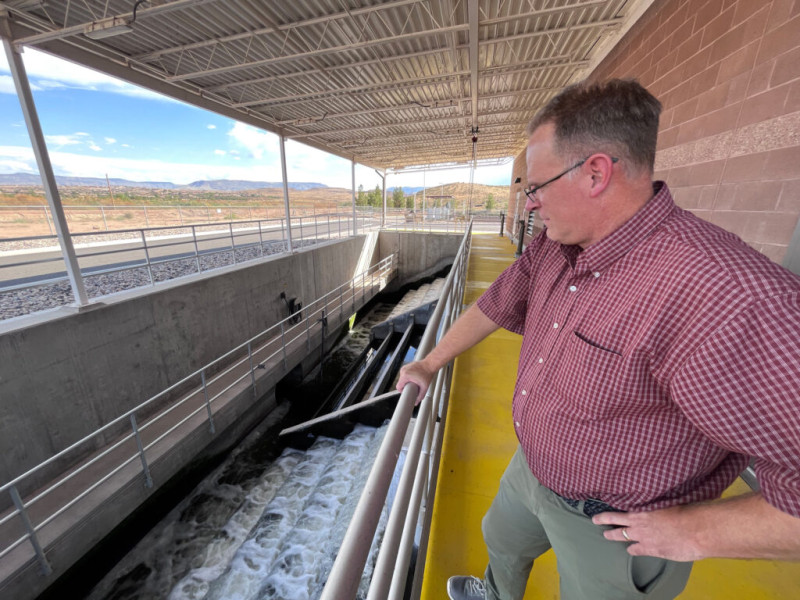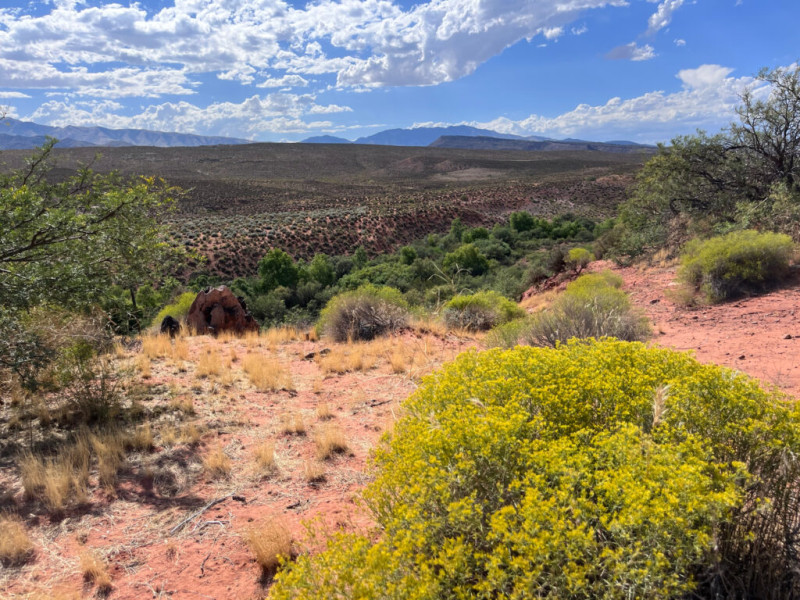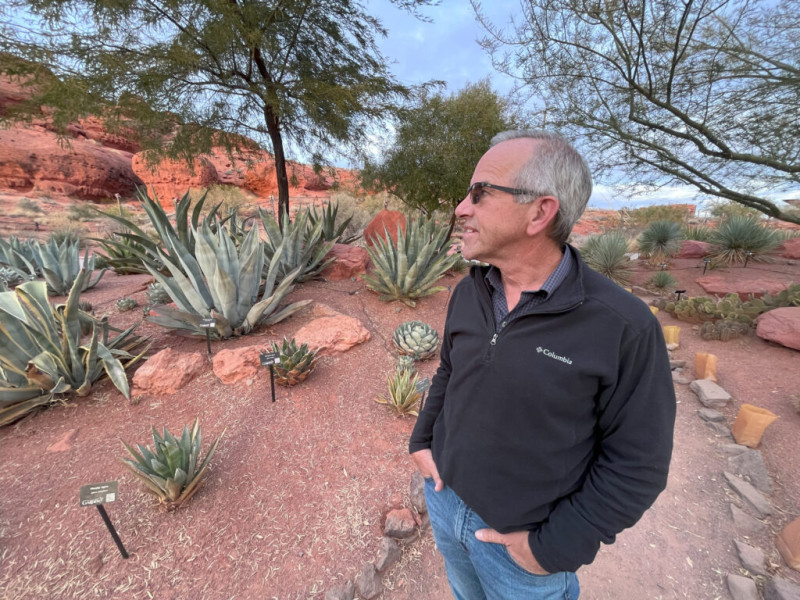How One of the Nation’s Fastest Growing Counties Plans to Find Water in the Desert
Like many places across the West, two things are on a collision course in Utah’s southwest corner: growth and water.
Washington County’s population has quadrupled since 1990. St. George, its largest city, has been the fastest-growing metro area in the nation in recent years. And projections from the University of Utah say the county’s population—now at nearly 200,000 people—could double again by 2050.
But it also sits in the northernmost reaches of the dry, hot Mojave Desert. The region has essentially tapped out the Colorado River tributary it depends on now, the Virgin River.
So, the big question is: where will the water for all those new residents come from?
For nearly two decades, many Utahns thought the best answer was to build a pipeline to Lake Powell—a 140-mile, $2.2 billion straw across the red rock desert. The idea gained so much support that Utah’s Legislature officially approved it in 2006.
We’re hiring!
Please take a look at the new openings in our newsroom.
See jobsAt the time, Washington County Water Conservancy District General Manager Zach Renstrom said there wasn’t much reason to think that plan would fail.
“Fifteen years ago, Arizona didn’t care if we built the Lake Powell Pipeline. Nevada was fine,” Renstrom said. “Nobody cared.”
In recent years, however, the idea has become more of a controversial pipe dream than a feasible solution.
More than two decades of dry conditions have put Lake Powell in dire straits, culminating with its drop to record low levels in 2023. Simultaneously, Utah and its neighboring states have become locked in a high-stakes fight over the future of the strained Colorado River, which fills the reservoir.
“In engineering, we always say, ‘The best way to determine the strength of a chain is to stress it and let it break,’” Renstrom said. “The river was getting to a breaking point … and the Lake Powell pipeline just happened to come at the exact same time when this was going on.”
But in Washington County, rapid growth has kept marching on. The conservancy district estimates the area will need an additional 46,615 acre-feet of water per year to meet the area’s expanding needs into the early 2040s.
An acre-foot is the amount of water needed to fill one acre of land to a height of one foot. One acre-foot generally provides enough water for one to two households for a year.
So local leaders are rolling out a $1.1 billion plan to help the county get by for the next 20 years without the pipeline.
“The well is running dry and we have to do these aggressive measures. And it’s coming with a big price tag,’” Renstrom said. “But when you see the alternatives, everybody realized this is what we need to do.”
How the County Plans to Stretch Its Water
The district’s 20-year plan comes down to two big ideas: reusing and conserving the water it already has.
At the St. George water treatment plant, Water Director Scott Taylor stood on a platform watching a concrete waterfall flow into an underground pipe. This water—he estimated millions of gallons a day—rushed downstream toward Lake Mead and out of St. George’s grasp.
“All that water that’s going in that pipe is flowing straight out into the Virgin River,” Taylor said. “So it lets me know that we have a resource we can better develop and use.”

This is one water source that’s expected to grow along with St. George’s population in the coming years—the wastewater that comes from people flushing their toilets and taking showers.
Through emerging technology, the city can clean sewage enough to recycle it back into the system. It could irrigate farms, golf courses and parks and leave more in the tank for drinking.
“For every gallon of reuse water that we can use outside,” Taylor said, “that frees up that gallon of culinary water for future growth of the area.”
St. George already does some wastewater recycling, and plans to ramp that up significantly in the coming years. Right now, however, the city doesn’t have enough space to store more of that recycled water, which is why so much has to flow out that concrete cascade at the plant.
So, the city is finalizing plans to build Graveyard Wash Reservoir, a 2,100 acre-foot bank dedicated to saving recycled wastewater for a non-rainy day. If all goes well, Taylor said, it could be ready by 2025. Once it’s filled, the plan is to eventually build at least two more reservoirs to further expand the region’s ability to store water for reuse.
Wastewater reuse is the bedrock of the 20-year plan, slated to supply about half of the new water the region needs. The plan expects smaller slices of water to come from things like drilling and expanding groundwater wells and from the likely transition of farmland into residential neighborhoods, since homes generally use less water per acre than crop fields.

Conservation Contagion
Many of those endeavors will take years to come to fruition, however. That makes increasing conservation—which is expected to supply roughly a quarter of the new water in the plan—even more critical today.
That’s why the district began paying residents to rip out their thirsty grass lawns in favor of landscaping that requires less water a little over a year ago.
In a garden near his office, Conservancy District Conservation Manager Doug Bennett took a walk past an assortment of native desert plants, from cartoonishly large agave to dainty flowers. It’s a demonstration garden run by the district and the city of St. George that hopes to give residents a picture of how beautiful xeriscaping can be and help more people feel confident in their ability to leave grass behind.
Finding ways to ramp up these conservation efforts are vital to the area’s survival, Bennett said, even if getting residents to break from the status quo isn’t always easy.
“They might live on a street where everybody has grass in their front yard and they’re like, ‘I don’t know if I want to be that guy that sticks his neck out and does something weird and everybody looks at me funny,’” Bennett said. “As soon as somebody does it, it becomes a contagion.”
Washington County is already replacing its lawns faster than any other part of Utah. One year into its turf removal rebate program, county residents have ditched more than a million square feet of grass. The district estimates those lawn conversions will conserve 45 million gallons of water per year going forward.

“Every three conversion projects that we see produce enough water savings to support two water efficient households,” Bennett said. “That’s really important in a fast-growing community like ours.”
Although the county has less than 6 percent of the state’s population, he said, it accounted for more than a quarter of all the grass replaced statewide in 2023.
This early success has made Bennett confident the district can double the results from its first year and convert two million square feet of grass in 2024. He knows it’s possible, too—he helped build a similar program in Las Vegas, where residents have replaced more than 200 million square feet of grass in the past two decades.
‘Then What?’
Reaching the 20-year plan’s conservation goals will require a sea change in the county’s mindset about water use, said Ed Andrechak, Conserve Southwest Utah vice president and water program manager. But he believes it can happen.
In the past couple of years, he has started to see a shift toward a conservation culture, with fewer people counting on the Lake Powell Pipeline to solve St. George’s water worries.
“The LPP has always been held out there as the golden goose,” Andrechak said. “For the first time, public authorities, elected officials, appointed officials, the (conservancy district) have said, ‘No, it’s not going to be in the near future.’”
But he has concerns that the area’s water leaders might not be planning far enough, fast enough. The proposals in the plan make for a good start, he said, but he’d like to see the county adopt additional ideas used elsewhere in the West, such as capturing and reusing water from storm sewers on a localized scale, to throw every possible solution at this problem.
Tiered water rates—where customers pay a steeper per-gallon price as they use more water— already exists in Washington County. But for those using the most water, he said, rates should be even higher to get their attention.
“We really have to mash on the accelerator in terms of increasing pricing,” he said. “It’s politically probably difficult and people might get voted out of office. But I think people need to be courageous and do the right thing.”
Washington County’s conservation numbers have slowly begun to improve since 2005, when daily water use ballooned to 391 gallons per person. By 2020, water use dropped to 285 gallons per person per day, and there’s still plenty of room to improve. The 20-year plan’s goal is an 18 percent reduction in water use among existing households by 2042.
The lingering question will be how long can all these water-stretching endeavors sustain St. George’s growth.
“I think by their own words, they would say, ‘Yes, we’ll get all this done and it’ll generate enough water to meet the demand through about the end of the 2030s,’” Andrechak said. “Then what?”
That’s where Washington County’s water future gets even more murky. Conservancy district manager Renstrom estimates the 20-year plan can stretch the area’s water supply enough to sustain population growth up to around 350,000 residents.
But he acknowledges the plan isn’t meant to be a long-term solution. It’s essentially about buying more time.
“I think in 15 years, about the time I’m retiring, we’re going to have to have another very intense conversation about what we’re going to do here in this county,” he said.
Someday, he said, that may mean city leaders have to halt growth entirely and stop building new homes. Maybe the area will need to eliminate parks. Or start recycling sewage into drinking water.
But he also points out that the state of Utah continues to believe it has the right to pull more water from the Colorado River system than it currently does, based on its allocation from the decades-old legal agreements that define how water is shared in the West.
Even the 20-year plan describes the Lake Powell Pipeline as a “critical component” for meeting the area’s long-term needs. So at least in some corners of southwest Utah, the debate about whether or not the pipeline can ever become a reality may be far from over.
This story is part of ongoing coverage of water in the West, produced by KUER, distributed by KUNC, and supported by the Walton Family Foundation. KUNC is solely responsible for its editorial coverage.
Share this article
Disclaimer: The copyright of this article belongs to the original author. Reposting this article is solely for the purpose of information dissemination and does not constitute any investment advice. If there is any infringement, please contact us immediately. We will make corrections or deletions as necessary. Thank you.







